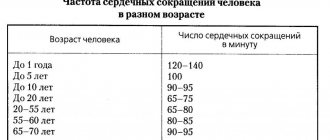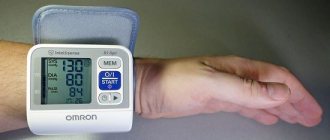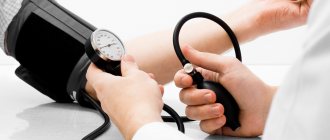In this article:
- What is pulse?
- Correct measurement algorithm
- How to measure pulse using a tonometer?
- How does a pulse oximeter work?
- Benefits of a heart rate monitor
- What can fitness bracelets do?
- Pros of using devices
- How to evaluate heart rate?
Pulse measurement is the easiest and most accessible way to assess the condition of the cardiovascular system. You can determine your indicator at home, while walking, or in any other circumstances. To calculate your heart rate manually, a regular watch with a stopwatch is sufficient, but you can also use modern gadgets that will determine and store the resulting value in memory.
How to measure pulse in the neck correctly
To correctly measure your neck pulse, it is important to consider:
- the patient's position is only sitting or lying down;
- the pressure should be light, since with strong pressure the heart rate slows down, in sensitive patients there is a risk of cardiac arrest;
- if it is necessary to determine the heart rate on both sides, you should alternately count the pulse on the right and left; while simultaneously pressing on the projection points of the carotid arteries, dizziness and lightheadedness may occur;
- before starting the stopwatch, you need to find the pulsation point with two fingers on the side of the thyroid cartilage (Adam's apple);
- repeated measurements are carried out at intervals of 5-7 minutes to restore the heart rate.
What is pulse?
First, you need to define the basic concepts, figure out what and why you will measure. Not everyone knows that heart rate and pulse are not the same thing. The first indicator reflects the number of contractions of the ventricles of the heart per minute, i.e. how many times during this period the ventricles filled with blood and pushed it into the aorta and pulmonary artery. And the pulse is the number of vibrations in the walls of the arteries that occur due to contractions of the heart.
In a healthy person, these indicators are the same, but in some pathologies they may differ. The norm for an adult is a pulse rate of 60-90 vibrations per minute; in children, the indicator is determined by age. The younger the child, the faster his pulse. When measuring the pulse, the doctor determines several parameters:
- Frequency;
- Filling;
- Voltage;
- Height;
- Rhythm;
- Form.
By taking measurements yourself, you can only find out the frequency. But this indicator also allows you to evaluate the work of the heart, choose the right physical activity, and notice changes in time.
Correct measurement algorithm
There is a simple heart rate measurement algorithm that can be used in any circumstances. The pulsation can be clearly felt on the wrist, and equally on both hands. For such a measurement, several conditions must be met:
- Place your wrist at heart level in the palm of your other hand;
- Feel the pulse on the palmar side along the edge where the thumb is located (on the side of the little finger the pulse is usually not audible, this is due to the location of the radial artery);
- Wrap your fingers around your wrist so that your index finger is closer to the wrist joint;
- Apply gentle pressure with your fingertips on the wrist in the direction of the radius.
In this case, the middle and index fingers should feel the pulse wave - rhythmic vibrations of the artery wall. It is necessary to note the time and count the number of beats per minute.
Alternatively, you can measure your pulse in your neck. To do this, you need to find the carotid artery: run your fingers from the back corner of the lower jaw down the neck. However, it is believed that determining the pulse on the hand is more comfortable, and its results are more accurate.
Respiratory arrhythmia
Arrhythmia is a disturbance in the normal rhythm of the heart. Sometimes it can be related to breathing. At the same time, when a person inhales, the heart begins to beat faster, and when he exhales, it slows down.
This is interesting!
It’s still interesting how different we are from our smaller brothers! For us, respiratory, or, as it is also called, sinus arrhythmia, is a violation of the normal rhythm of the heart, but for dogs, for example, this condition is the norm.
Outwardly, respiratory arrhythmia does not manifest itself in any way, but it is not difficult to determine it by the pulse: just pay attention to the increase in the amount of will during inhalation and the decrease during exhalation.
How to measure pulse using a tonometer?
You can use special instruments for measurements. There are several options to check your pulse and at the same time find out some other important indicators. One of them is a tonometer. Such a device records pulse and blood pressure, and modern models are capable of:
- Save results in memory;
- Compare indicators with the norm, identify deviations;
- Calculate average values for a certain period;
- Transfer information through applications to mobile devices or to a computer, where you can conduct a full analysis, including using graphs and diagrams.
To get accurate results, you need to take measurements correctly. Measurements are taken in a sitting position, the cuff on the arm should be at the level of the heart. It is important to calm down and comply with all the requirements listed in the instructions for the device.
Automatic blood pressure monitors inflate the cuff themselves and take measurements. The user can only estimate his pulse and pressure using the numbers on the display.
Types of Heart Rate Monitors
Based on the method of obtaining information about the pulse, heart rate monitors are usually divided into chest-mounted heart rate monitors and optical sensors. The latter can be built into sports watches or fitness bracelets, as well as in the form of separate devices. Look at the picture and it will become clearer.
Heart rate sensors in watches
Most smart and sports watches are equipped with an optical heart rate monitor located on the back. This is the most popular type of heart rate monitor because it is essentially an additional option when purchasing a watch.
An LED and a photocell are responsible for recording the pulse. The first directs light into soft tissues, the second records the amount of blood in the vessels. The more blood, the less reflected light and vice versa. You can read more about the method of operation of the device here.
The advantage of such a device is the ease of wearing and round-the-clock heart rate monitoring. The need to monitor heart function may be determined by the user’s desire or medical reasons. For example: having a pacemaker, or having undergone heart surgery.
However, it should be noted that this is the least accurate method of measuring pulse. This is due to the fact that on the wrist, where the watch is located, there is a wrist joint and a small amount of soft tissue. Plus, if the strap is not fastened tightly, the watch can move on your hand, which causes additional errors.
Chest heart rate monitors
The second most popular way to measure heart activity is using a chest strap. It is more reliable and accurate, but less comfortable, since it must be on the chest during measurement.
The operating principle is based on recording the electrical activity of the heart. This is the most accurate method today. It is well known to those who have done electrocardiography of the heart. If you need details you can look here.
Another feature of the bib is that it records your heart rate and transmits the value to a compatible device. It can be a sports or smart watch, a smartphone, a cycling computer, a machine in a fitness center, etc. From the screens of these devices you can monitor your heart rate and control its value.
Recommended reading: Chest heart rate monitor or watch with an optical sensor
Optical heart rate monitors on the arm
This is the most unpopular option for measuring heart rate. Although, completely undeserved. It works on a similar principle to the optical sensor in a watch, but is made as a separate device that is attached to the shoulder or forearm.
In terms of accuracy, it takes an honorable second place after the breastplate. Due to the fact that it is located in places where there is a sufficient amount of soft tissue filled with blood vessels, its data is very correct.
Similar to the bib, it transmits data to watches, smartphones and other devices. But in terms of comfort, it surpasses it, since it does not constrict the chest and does not fly off during very intense exercises.
Recommended reading: Practical review of the Polar OH1
How does a pulse oximeter work?
Another modern pulse device is a pulse oximeter. Its functions are to determine saturation and count the heart rate (pulse rate). This is a medical device, before using it you need to understand the features of its use.
So, pulse oximeter – what is it and how does it work? The device is equipped with two light sources with different wavelengths and a photosensor that detects the reflection/absorption of light waves by various tissues. The light is partially reflected/absorbed when passing through soft tissues and blood, this makes it possible to determine saturation - the saturation of arterial blood with oxygen as a percentage. The normal rate varies from 95% to 100%; lower values indicate malfunctions in the functioning of the body systems.
To measure your pulse with this device, you need to attach the sensor to your fingertip, press the button and wait a few seconds. The display will show two indicators simultaneously: pulse and saturation. If the values are outside the normal range, a beep will sound.
Benefits of a heart rate monitor
Tonometers and pulse oximeters are medical devices and are convenient to use at home. But many convenient gadgets have been created for people who prefer an active lifestyle. There is even a special device for measuring pulse, which is called a pulsometer.
Basically, devices of this type look like a wristwatch and are used to assess the effectiveness of physical activity by measuring heart rate. In addition to counting your pulse, heart rate monitors perform many useful functions:
- Calculate the average heart rate;
- Determine the maximum values;
- Allows you to set up an individual training zone and notifies you when you go beyond it with an audible signal;
- Equipped with a countdown timer;
- Show date, time, day of the week;
- Works as a stopwatch and alarm clock;
- They are synchronized with special software to transfer data to a phone or computer, where the dynamics can be analyzed.
Many devices provide additional functions, for example, determining the height or number of laps while running, calculating energy consumption, recording the acceleration of the legs, and others. Some models are equipped with a chest belt. The main advantage of heart rate monitors is the most accurate pulse determination, comparable to ECG data.
What can fitness bracelets do?
One way to check your pulse and get a lot of other useful information is to use fitness bracelets.
The compact device is fixed on the wrist according to the same principle as a watch. It doesn’t interfere with work, walking, training, and it’s even comfortable to sleep with. All this time the device measures:
- Number of steps taken and distance in km;
- Duration of sports training;
- Achievement of set goals in %;
- Volume of calories burned;
- Duration and quality of sleep.
The range of options depends on the model. For example, some devices synchronize with a smartphone, inform about incoming calls and messages, and transfer the results of all measurements to a mobile device for subsequent analysis. All fitness bracelets function as watches and alarms.
Pros of using devices
Such devices are very popular due to their many advantages:
- A person can always evaluate his physical activity and, if necessary, adjust it;
- Calorie counter helps you stay fit;
- Heart rate measurement is carried out in real time with high accuracy;
- The cost of the devices is quite affordable;
- The bracelets look stylish and elegant;
- The device combines many useful functions.
In addition, fitness bracelets are easy to use. With their help, it is convenient to monitor your pulse during training without being distracted by taking measurements. Just place your finger and wait a few seconds for the measurement result.
What to look for when choosing a monitor
Given the variety of options, choosing a monitor will largely depend on a number of criteria. These include the goals you set for yourself, the type of sport you plan to engage in, the intensity of your training and the technical features of the devices. Below we will discuss each criterion in detail and hope to make your choice much easier.
Purpose of using the monitor
From experience we can say that usually a heart rate monitor is purchased to solve one of two problems:
- 24/7 heart rate monitoring
- Heart rate monitoring during sports
Goal 1 – 24/7 heart rate monitoring
Only watches or fitness bracelets with an optical heart rate sensor are suitable for this. The device will record your pulse constantly – while you are awake and asleep. As a rule, each watch brand has its own mobile application in which you can view a heart rate graph.
In addition to the pulse, other information will be available that is either based on or related to heart data. This includes correct calculation of daily physical activity, assessment of physical activity and recovery status, and sleep tracking.
When purchasing a watch for 24-hour heart rate monitoring, we recommend paying attention to accuracy indicators. The fact that there is an optical heart rate monitor in the watch does not at all guarantee the accuracy of the data. If heart rate monitoring is necessary for medical reasons, then this parameter becomes critically important.
Pay attention to recognized brands, read reviews, ask consultants for information. For our part, we recommend watches with a heart rate monitor from the POLAR brand. This is a trusted manufacturer that has been producing heart rate monitors since 1978. We test all devices ourselves and can guarantee accuracy when used correctly.
We recommend reading: Review of Polar Ignite after one month of use
Goal 2: Monitor your heart rate during sports
In this case, any type of heart rate monitor can be used. Taking into account the recommendations for comfort and accuracy that we described above. For understanding, here is a graph of the relationship between comfort and accuracy of monitors when playing sports. Each device was roughly rated on a 10-point scale for both parameters. There are no calculations here - this is done for clarity.
It is important to understand that this schedule is based on ideal operating conditions. That is, the devices are put on correctly, the optics fit tightly to the skin, and the chest strap electrodes are moistened for good contact.
We recommend buying Electrode gel for chest monitor
Type of sport and planned intensity
Using a heart rate monitor while playing sports allows you to correctly determine the effect that physical activity has on the body. The higher the intensity of the exercise, the higher the heart rate. It is known that there are 5 pulse zones, work in which has completely different effects.
Therefore, your heart rate data during exercise must be correct and up to date. And here we come to some nuances that may arise if you use the wrong type of monitor for some sports activities. Let us immediately note that these points are of a recommendatory nature and are determined solely by our experience in conducting training.
Nuances associated with the sport
- In sports where there is intense hand movement, watches with an optical sensor may produce errors. They can move on the wrist, thereby interfering with quality data. An example would be sprinting, where the athlete makes sudden movements with his arms to help himself run, or basketball.
- When using an optical sensor for swimming, it is necessary that no water gets between the photocell and the skin, as it refracts light and creates interference. Press the sensor as tightly as possible.
- Winter sports such as skiing and biathlon require outdoor training. The watch is usually worn over a sleeve, so the optical sensor will not work. Only a chest heart rate monitor will save you here.
- Sports that involve lying on your stomach - gymnastics, certain types of strength exercises. A chest strap is not suitable, as it can put painful pressure on the solar plexus.
Nuances related to intensity
There is a very simple rule here: the more intense the training, the greater the need to purchase a chest monitor. Only he can correctly record the pulse under extreme loads. For an example, look at the graph below, which shows two heart rate curves from a running workout. The first is the Polar H10 chest heart rate monitor, the second is the Polar OH1 optical sensor.
In general, it can be seen that the data from the devices is almost the same. However, if we look in detail at the period where the athlete runs with maximum effort, we can see that there are discrepancies.
The fact is that with a very high pulse, optical sensors do not have time to register blood flow, since it changes at high speed. As a result, errors may occur. The breastplate does not have this problem.
Another point worth mentioning is the slight inertia of optical heart rate monitors. If your heart rate increases sharply, the chestpiece will instantly react and show the correct data. The optics will do this with a slight delay. Please take this into account. If you run intervals, tempo training or fartlek, then only a bib will save you.
Ideally, of course, for conscious exercise, you need a set consisting of a watch with an optical sensor and a chest heart rate monitor. The first monitors heart rate around the clock, coupled with a number of additional functions. It can also be used for light workouts. And when intense training is planned, a bib is put on.
buy a discounted Polar watch complete with a chest heart rate monitor here.
Monitor brand
The heart is the most important organ in our body. Therefore, it is better to control it with understandable brands with a good reputation. In this case, we can promise guaranteed accuracy and durability of the device. Recognized leaders or have their own laboratories for improving heart rate recording technologies. Or they use technologies from direct competitors.
We recommend paying attention to the following trusted manufacturers of sports heart rate monitors:
- Polar (Finland) – specializes in heart rate monitors since 1978.
- Garmin (USA) - started with mobile navigation systems, then began producing sports watches. They have existed since 1989.
- Suunto (Finland) - produces compasses, watches for tourism and sports since 1936.
- Wahoo Fitness (USA) is a developer of cycling computers, exercise bikes and heart rate monitors. Operating since 2010.
The cost of devices can start from several thousand rubles and reach 100 thousand or more. It all depends on the type of device, functionality and brand.
The cheapest and most accessible are chest heart rate monitors and optical sensors in the form of separate devices. Their cost starts from 4 thousand rubles. If this is your first device of this kind, we recommend starting with them.
At first, they can be used in conjunction with a smartphone, or with an existing smartwatch, such as an Apple Watch. This kit will allow you to fully monitor your heart rate during training.
Recommended reading: Chest heart rate monitor for Apple Watch and iPhone
Data transmission format
This nuance must be taken into account first of all when purchasing chest-mounted and stand-alone optical heart rate transmitters, since they work in tandem with a watch, smartphone and other devices. Information is transmitted using wireless technology. Today there are three formats. They are presented below in descending order of popularity:
- Bluetooth Smart is the most common option. Supported by most heart rate monitors and all smartphones, smart watches, sports watches, tablets, computers, etc. Consumes little energy. The only negative is that it does not transmit a signal through water, which makes it impossible to use when swimming.
- ANT+ is actively used in the world of sports electronics. Garmin uses it in its products. However, it is rarely found on smartphones and other smart devices. Keep in mind that if your heart rate monitor only supports this channel, then you will definitely have difficulties with synchronization.
- GymLink – data transmission is carried out at a frequency of 5 kHz. This is the rarest format. It is supported by many cardio equipment, particularly treadmills and exercise bikes. The beauty is that if you exercise on a treadmill, your current heart rate is reflected on the screen of the exercise machine in real time.
It is important to understand that different heart rate sensors support different data formats. For example, Polar sports watches only work via Bluetooth. At the same time, the chest heart rate monitors of this brand support all data transmission formats. Garmin watches, on the contrary, support Bluetooth and ANT+, and most sensors only work with ANT+.
Below is a table with information about the support of communication channels by products of different brands.
Design features of heart rate monitors
When producing monitors, each manufacturer introduces features aimed at increasing the accuracy and comfort of using the device. Conceptually they look the same, but as they say the devil is in the details. Here are a number of points that are worth paying attention to.
Number of LEDs and photocells
For full operation of an optical monitor, one LED and one photocell are enough. However, their number varies from model to model. You can find devices with 10 LEDs.
In general, the more LEDs, the more objective the data, since the area of transillumination of the vessels is larger.
Features of the optical monitor surface in watches
If you look at some watch models in profile, you can see that the heart rate sensor protrudes slightly above the surface of the case. This is done to ensure that contact with the skin is as dense as possible, which increases the accuracy of the data. When choosing, pay attention to such models.
In addition, additional elements can be seen on the surface of the sensor. In particular, the Polar company installs electrodes that are responsible for the tightness of pressing the sensor to the surface of the wrist. In the photo, the electrodes are represented by 4 light circles.
A small electric current passes through them. When the watch moves away from the skin, the electrical circuit is interrupted and the device understands this and corrects the pulse value.
Chest monitor integrity
Chest heart rate monitors consist of two parts: a heart rate sensor and a chest strap. They can be a single whole, or they can be separate. In the second case, the sensor is securely attached to the belt using special buttons. After training, the belt can be washed separately, and if it becomes unusable, it can be replaced. At the same time, the sensor itself remains the same.
In the case of a complete structure, damage to the belt will make it impossible to operate the entire monitor.
Recommended reading: Polar H10 – review of the chest heart rate monitor
Additional functionality of a chest heart rate monitor
Some chest heart rate monitors have a built-in accelerometer. Due to this, they measure not only heart rate, but also reflect running dynamics data, namely:
- cadence - number of steps per minute.
- ground contact time for each leg.
- vertical vibrations. How high does the athlete's body rise at the moment of kicking off?
To view this information, you need a compatible device - a watch or smartphone. The need for this information for each user is a purely personal question. But know that the presence of an accelerometer immediately adds several thousand rubles to the price.
Wahoo Fitness and Garmin have monitors with this feature.
How to evaluate heart rate?
Self-monitoring your heart is quite easy, especially with heart rate bracelets and other smart devices. But it is also important to evaluate the results correctly. To do this, you should take into account several nuances:
- The normal pulse at rest is 60-80 beats per minute;
- For women, the rate is 5-10 beats higher;
- The pulse in a lying position is minimal, in a sitting position it increases by 4-6 beats, while standing - by 10-14 beats per minute;
- In winter, the rate may be lower than in summer;
- Throughout the day, the pulse changes from the slowest at night to the maximum at 18-20 hours, increasing at 8-12 hours and about 15 hours, but it all depends on the daily routine of a particular person;
- After eating hot food and drinks, the pulse quickens.
Heart rate is related to physical activity: the more intense it is, the higher the indicator will be. During active sports, the heart rate increases to 150 beats per minute. A level of 200 blows is considered critical; at this level, the load must be reduced. In athletes, the heart muscle is more trained, so the heart rate during exercise grows more slowly than in an ordinary person.
Before checking the pulse on your hand or assessing the performance of special devices, it is worth considering the factors that influence the heart rate. The pulse increases not only due to physical activity. This effect can be caused by stressful situations, overeating or severe hunger, drinking alcohol or smoking, and even massage.
A heart rate deviation of 10% or more from normal may be a cause for concern. For example, if you have a constant rate above 90 beats per minute under the age of 30, you should consult a cardiologist. A decrease to 50 beats or below may also indicate the development of pathological processes in the body. A drop to 40-35 beats indicates a real threat to life.
Pulse measurement allows you to monitor the condition of the body, obtain objective indicators of the functioning of the heart and blood vessels, and promptly identify deviations. You can determine the indicators yourself manually or using special devices that monitor the pulse automatically with high accuracy.
Opinion of an experienced therapist
Many people are looking for answers to questions about how to reduce a high heart rate and what indicators are considered normal. Alexander Shishonin noted that each age category of patients has its own standards.
So, the normal heart rate for adults is 60-70 beats per minute. If a person’s pulse is 80, then this is also not considered a pathology. Below or above the indicated numbers is already a deviation. As Dr. Shishonin notes, a low pulse is more dangerous to human health than a high one.
In medicine, a low pulse is called bradycardia, a high pulse is called tachycardia. Hypertension is often accompanied by a rapid heart rate. Hypoxia disrupts the functioning of the brain, including the vascular center. In order for the body to work normally, the brain gives an order, as a result of which the pressure or pulse, that is, the heart rate, increases.
Recommendation. In order to reduce a high pulse, if it occurs against the background of hypertension provoked by cervical osteochondrosis, you can use neck gymnastics developed by Dr. Shishonin. Simple exercises help saturate the brain with oxygen, as a result of which the heart rate automatically decreases.
To download gymnastics, join our community “Club of Former Hypertensive Patients”
. Information is provided free of charge. There you can also learn more about many other aspects of health related to blood pressure, osteochondrosis, atherosclerosis, ask your questions to Dr. Shishonin and just chat.
It is so inherent in nature that the centers that regulate our breathing and heartbeat work together, therefore, with tachycardia, so-called shallow breathing occurs. And as soon as a person begins to consciously inhale deeply, with a pause on inhalation and exhalation, he will notice that after 5 minutes. By breathing this way, the tachycardia will decrease and he will feel better.
In emergency cases, when the heartbeat reaches 180-200 beats/min, you need to call an ambulance. Before her arrival, you need to induce vomiting, then exhale deeply and inhale through your nose. It is also useful to press firmly on the area of the inner corner of the eyeball for several seconds. A light neck massage will also not hurt in this case. These simple steps will help reduce your heart rate to acceptable levels.










